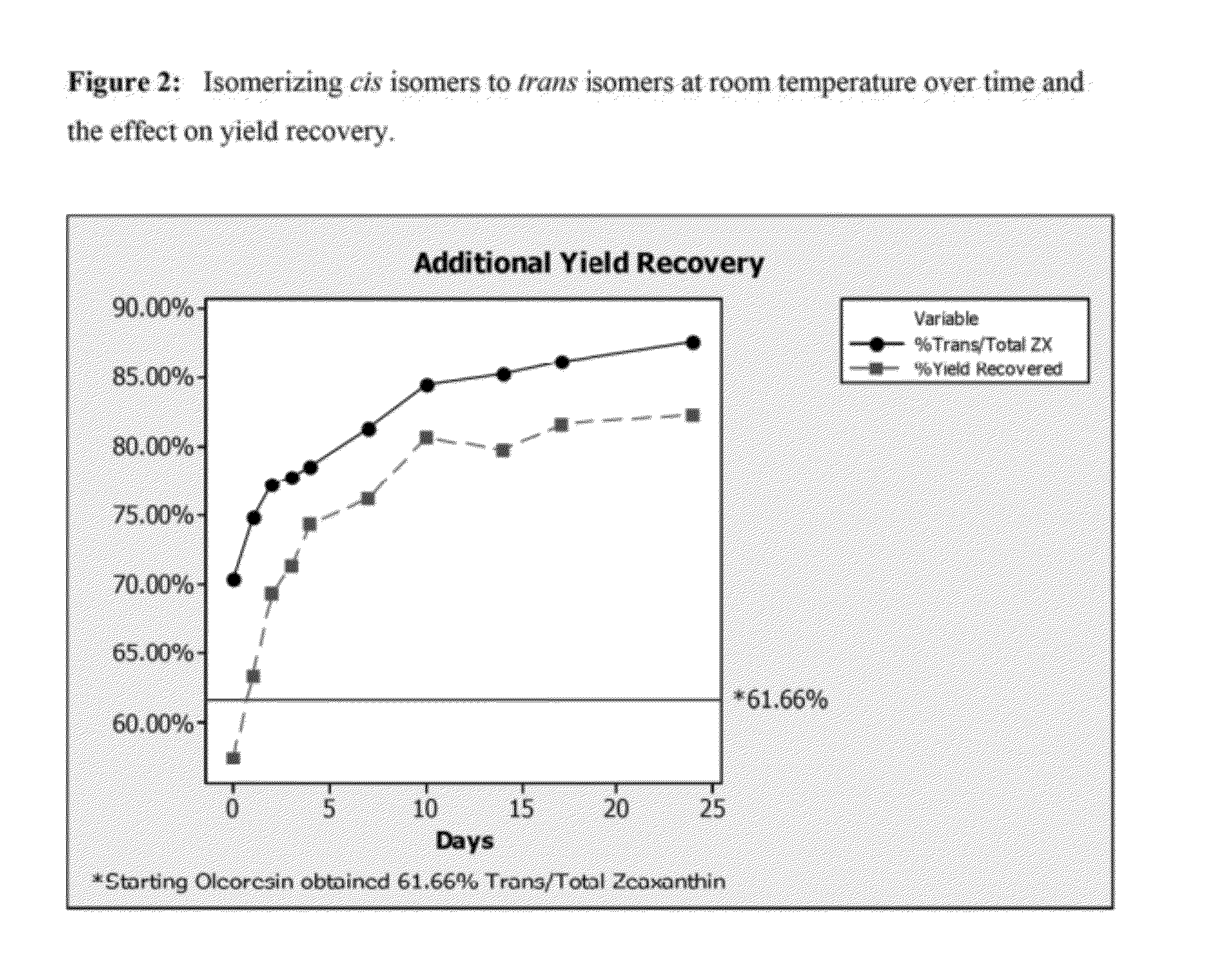Methods of saponifying xanthophyll esters and isolating xanthophylls
a technology of xanthophyll and esters, which is applied in the field of saponification of xanthophyll esters and isolating xanthophylls, can solve the problems of unfavorable cost-effective increase in yield, and achieves the effects of sufficient purity, practical and effective, and sufficient yield
- Summary
- Abstract
- Description
- Claims
- Application Information
AI Technical Summary
Benefits of technology
Problems solved by technology
Method used
Image
Examples
example 1
[0045]An orange paprika extract (oleoresin) containing 2.68% total zeaxanthin (40.36 g) was placed in a 500 mL 3-necked, round bottom flask equipped with an overhead stirrer, heating mantle, nitrogen inlet and outlet, and thermometer. Isopropyl alcohol (60.07 g), water (reverse osmosis-grade, 60.06 g) and potassium hydroxide solution (45%, aqueous, 30.03 g) was added. The reaction was stirred and heated under nitrogen until the reaction reached 65° C. The temperature was maintained for 90 minutes and complete saponification was confirmed by thin layer chromatography. The heat and stirring was turned off while keeping the round bottom flask in the heating mantle to assist in slow cooling to promote larger crystal growth. The reaction was allowed to stand for 72 hours to allow crystallization to occur. The mixture was then filtered through fluted filter paper. The precipitate was collected and mixed with agitation with 100 mL reverse osmosis-Ode water for 30 minutes. This wash / precipi...
example 2
[0046]The process described in Example 1 was repeated using a starting material that was higher in both trans / total zeaxanthin ratio as well as total zeaxanthin concentration. Results are given in the Table 3.
TABLE 3Results zeaxanthin (Zea) for the experiment described in Example 2.Purity of ZeaxanthinIsomer FractionMassg Transg Cisg Total% Trans% Cis% Total% Trans in% Cis inSample(g)ZeaZeaZeaZeaZeaZeaTotal ZeaTotal ZeaStarting44.086.2160.1306.34614.100.2914.4097.96%2.04%MaterialRecovered15.795.6470.1005.74735.760.6436.4098.25%1.75%Precipitate% Yield of Recovered90.84%77.49%90.57%Zea in Precipitate vs.Starting Material
[0047]The recovered precipitate in this example was not dried prior to HPLC analysis. It contained 44.13% solvent (water and IPA). Adjusting for the solvent and water and then calculating purity on a dry weight basis would have brought the % total zeaxanthin purity up to 65.15%, which is consistent with the recovered total zeaxanthin purity reported on a dry weight bas...
example 3
[0048]Particle size plays a vital role in filtration efficiency, with larger particle size providing easier recovery. The particle size of the precipitating zeaxanthin crystal can be controlled by controlling a number of variables, with the easiest being temperature and time. A set of three experiments were run simultaneously to demonstrate the effect of temperature and time on the particle size of the precipitating zeaxanthin. Controlled, slow cooling provided larger particle sizes.
TABLE 4Experimental settings and results for Example 3.ExperimentABCStarting oleoresin (g)40.0140.0240.00Isopropyl alcohol (g)121.80122.85120.9645% aqueous potassium29.9930.0530.04hydroxide (g)Temperature of reaction (° C.)606060Reaction time (minutes)909090Precipitation conditions0° C.RoomSlow coolovernighttemperature(5° C. / hour) toovernightroom temp.Average crystal size (micron)24.1428.2771.04
[0049]Results for experiment C coincide with the typical 70-85 micron crystal size that is obtained with contro...
PUM
| Property | Measurement | Unit |
|---|---|---|
| Temperature | aaaaa | aaaaa |
| Temperature | aaaaa | aaaaa |
| Fraction | aaaaa | aaaaa |
Abstract
Description
Claims
Application Information
 Login to View More
Login to View More - R&D
- Intellectual Property
- Life Sciences
- Materials
- Tech Scout
- Unparalleled Data Quality
- Higher Quality Content
- 60% Fewer Hallucinations
Browse by: Latest US Patents, China's latest patents, Technical Efficacy Thesaurus, Application Domain, Technology Topic, Popular Technical Reports.
© 2025 PatSnap. All rights reserved.Legal|Privacy policy|Modern Slavery Act Transparency Statement|Sitemap|About US| Contact US: help@patsnap.com


